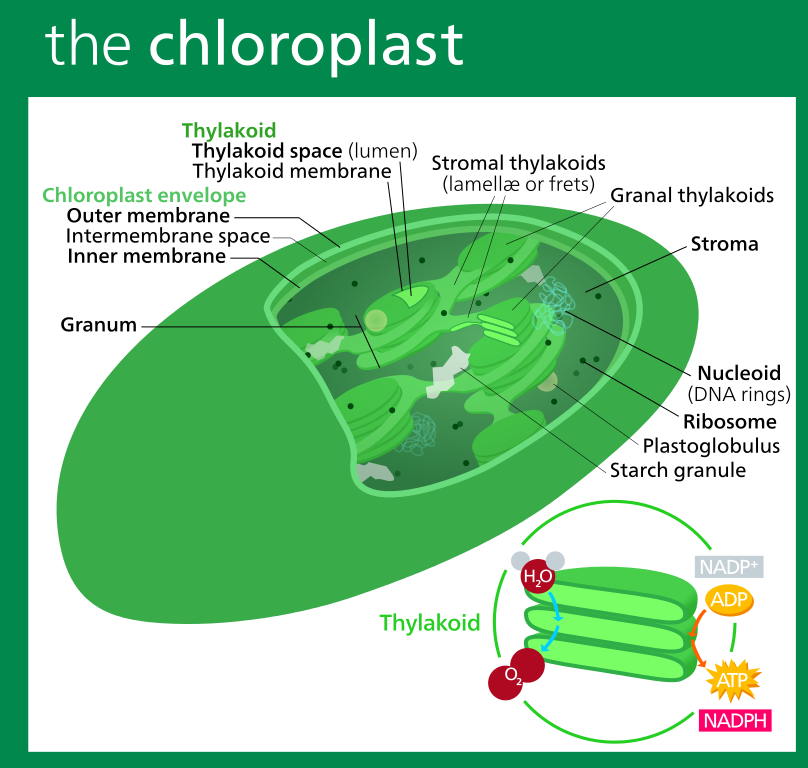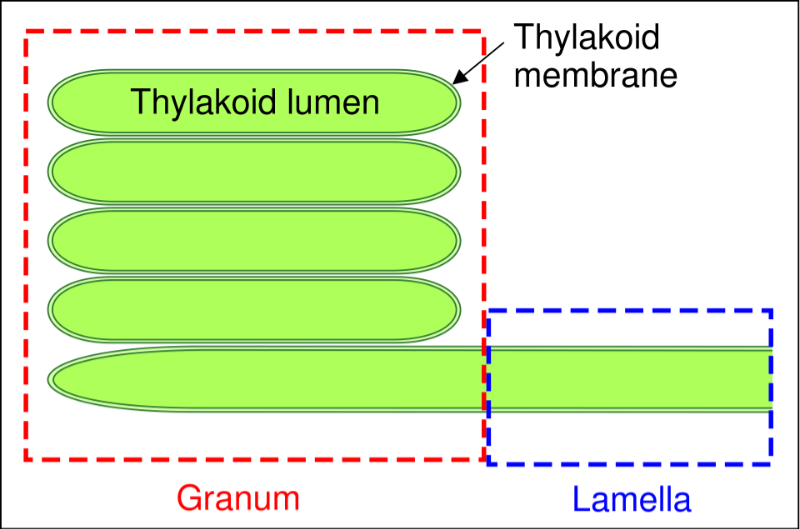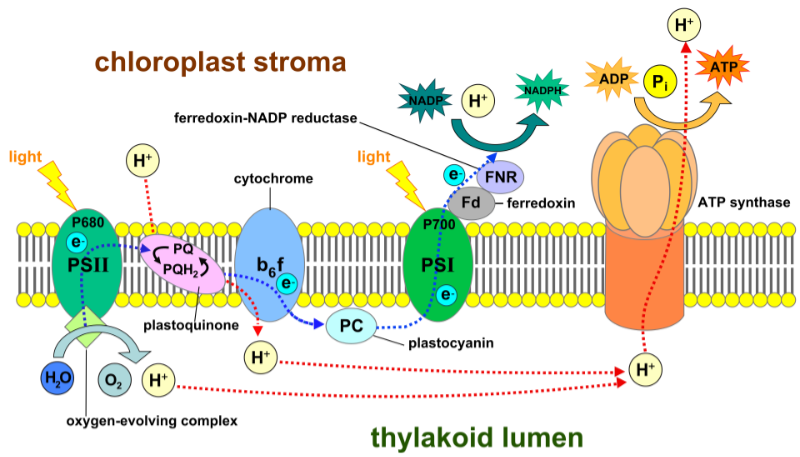The Thylakoid
What Are Thylakoids?
Thylakoids are unique to chloroplasts and their ancestral cyanobacteria, and are where photosynthesis begins for both. This chapter will focus on the thylakoids in chloroplasts, but with references to cyanobacteria where relevant.
The thylakoids in chloroplasts form stacks of disks known as grana (plural form of granum), seen in Fig. 1 below:

Attribution: Kelvinsong, CC BY 3.0 , via Wikimedia Commons
(This figure shows the arrangement of thylakoids in cyanobacteria.)
Grana are suspended in an aqueous liquid called the stroma, which fills the entire chloroplast. The individual stacks are joined together by intergranal/stromal thylakoids, also known as stromal lamellae (’stromal plates’), to form a single functioning unit of many. Fig. 2 shows this arrangement:

Attribution: Public Domain, https://en.wikipedia.org/w/index.php?curid=10483833
and Fig. 3 shows a real-life arrangement within a lettuce slice:

(Top) 10-nm-thick scanning transmission electron microscopy (STEM) tomographic slice of a lettuce chloroplast. Grana stacks are interconnected by unstacked stromal thylakoids, called “stroma lamellae”. Round inclusions associated with the thylakoids are plastoglobules. Scalebar = 200 nm.
(Bottom) Large-scale 3D model generated from segmentation of tomographic reconstructions by STEM. grana = yellow; stroma lamellae = green; plastoglobules = purple; chloroplast envelope = blue.
Attribution: By Yuv345 - Own work, CC BY-SA 4.0, https://commons.wikimedia.org/w/index.php?curid=93345039
Thylakoid Structure
Each thylakoid has a membrane surrounding an aqueous lumen (Fig. 4).

Attribution: http://en.wikipedia.org/wiki/Image:Granum.png, CC BY-SA 3.0 , via Wikimedia Commons
Embedded in the membranes are four major protein complexes: photosystem II (PSII), cytochrome b6f complex, photosystem I (PSI), and ATP synthase (Fig. 5). These four complexes participate in a series of reactions called the light-dependent reactions of oxygenic photosynthesis, to produce two molecules: adenosine triphosphate (ATP) and nicotinamide adenine dinucleotide phosphate (NADPH).

Attribution: By Somepics - Own work, CC BY-SA 4.0, https://commons.wikimedia.org/w/index.php?curid=38088695
ATP is the molecule which stores potential energy to drive further biochemical reactions, and NADPH, together with its oxidised form NADP+, transfer electrons and protons (hydrogen ions, H+) to and from the enzymes needed to build molecules such as carbohydrates.
Light-Dependent Reactions of Photosynthesis
Production of NADPH
Photosystem I and II contain photosynthetic pigments: the carotenes, xanthophylls, phaeophytins, and the predominant chlorophylls which give chloroplasts their green colour.
Photosystem II initiates the light-dependent reactions. A chlorophyll a molecule in PSII absorbs a photon, which excites an electron that was produced elsewhere in PSII by splitting water into oxygen and hydrogen. This electron is at a high energy level, but is very unstable, and thus is transferred to another molecule, and another, resulting in a chain reaction of redox reactions through photosystem II, cytochrome b6f complex, and photosystem I, culminating in the formation of NADPH. These reactions will be explored in more detail in future chapters.
Production of ATP
The molecule adenosine diphosphate (ADP) is converted into ATP via a process known as photophosphorylation during photosynthesis. Cytochrome b6f complex and ATP synthase are the two complexes involved in this reaction.
Net Reaction
The net result of all light-dependent reactions in oxidative photosynthesis can be summarised as:
2H2O + 2NADP+ + 3ADP + 3Pi → O2 + 2H+ + 2NADPH + 3ATP
where Pi signifies inorganic phosphate.
Light-Independent Reactions of Photosynthesis
The light-independent reactions of photosynthesis aren’t reactions which occur in the dark or at night — photosynthesis doesn’t occur in these conditions — but rather are reactions which don’t involve a photon input.
Light-independent reactions occur outside the thylakoids, in the surrounding stroma. These take the ATP and NADPH generated by the light-dependent reactions to produce sugar from carbon dioxide and other compounds.
Net Reaction
These reactions are also known as the Calvin Cycle, and the net result is:
3CO2 + 6NADPH + 6H+ + 9ATP → glyceraldehyde-3-phosphate (G3P) + 6NADP+ + 9ADP + 3H2O + 8Pi
where Pi signifies inorganic phosphate and G3P enters other reactions to be converted into glucose.
Photosynthesis as a Whole
All the reactions of both the light-dependent and light-independent reactions can in turn be summed up with one net reaction for oxygenic photosynthesis overall:
6CO2 + 12H2O + photons → C6H12O6 + 6H2O + 6O2
This is the classic textbook equation for photosynthesis. But knowing what we know now, we can see how deceptively simple — and misleading —this equation really is!
The first revelation is that glucose (C6H12O6) isn’t even a product of photosynthesis. The actual sugar product is glyceraldehyde-3-phosphate (G3P), from the light-independent Calvin Cycle reactions of photosynthesis. G3P then enters pathways that are not involved with photosynthesis, to be converted elsewhere into glucose.
The second revelation is that each of the inputs and outputs are from two very different sets of reactions: the light-dependent set and the light-independent set. Carbon dioxide doesn’t really mix with water to produce sugar and oxygen — in fact, each are never in contact with each other, each come from a different set of reactions, and the reactions they enter are in different parts of the chloroplast.
Rather, water is split in the light-dependent photosystem II in the thylakoid membrane to produce highly-excited electrons and oxygen waste. The electrons enter still further light-dependent reactions in the membrane to eventually produce ATP for energy storage and NADPH for electron transport. (This is lithotrophy in action, with water as an inorganic electron donor source.)
Meanwhile, the carbon dioxide enters the light-independent Calvin Cycle in the stroma outside the thylakoid membrane. The carbon dioxide is ‘fixed’, with the help of the light-dependent ATP and NADPH products, into a non-glucose sugar and water. (This is autotrophy in action, with carbon dioxide as an inorganic carbon source.)
(To complete the picture, we know photons are the energy source, which is phototrophy. Altogether we have photolithoautotrophy in play.)
One other point to make concerns the 12 water molecules on the left, and the six on the right of the ‘photosynthesis equation’. Here it’s implied that only six were used with six spare. But what is really going on is that all 12 water molecules on the left were entering light-dependent reactions while the six on the right are by-products of light independent reactions.
The twelve were split fully in light-dependent reactions, to produce oxygen gas as a waste product and electrons that went on to make ATP and NADPH — there were no spares. Rather, these ’spares’ are in fact six water molecule by-products from carbon dioxide fixation from light-independent reactions of the Calvin Cycle.
Similarities With Cyanobacteria
ATP and NADPH/NADP+ are made and used by all life, though different lifeform groups may use different metabolic pathways to produce these. Here it is worth mentioning that cyanobacteria are the only photosynthesising bacteria with thylakoids, and the only oxygenic photosynthesising bacteria. Further, their thylakoids contain the same four protein complexes (with differences) as found in the thylakoids of chloroplasts. Cyanobacteria are so very similar in structure to chloroplasts, which they predate, that they are regarded as the ancestors of modern chloroplasts.
About the Author
BSc(Hons), U.Syd. - double major in biochemistry and microbiology, with honours in microbiology
PhD, U.Syd - soil microbiology
Stumbled into IT and publishing of all things.
Discovered jujube trees and realised that perhaps I should have been an agronomist...
So I combined all the above passions and interests into this website and its blog and manuals, on which I write about botany, soil chemistry, soil microbiology and biochemistry - and yes, jujubes too!
Please help me buy a plant if you found this article interesting or useful!